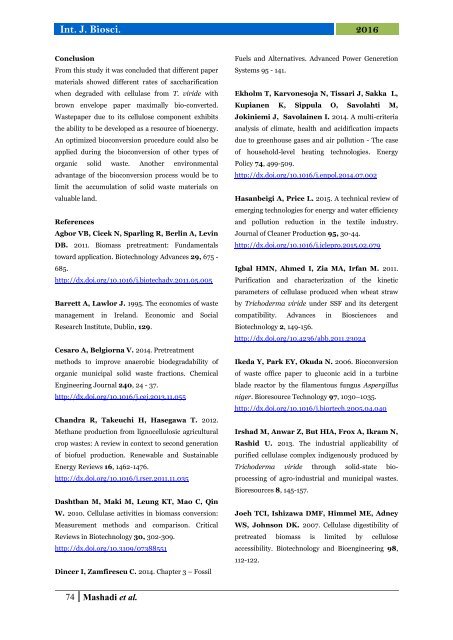Cellulas catalyzed bio conversion of different waste paper materials into ferment able sugars | By P. Mokatse
Cellulose catalyzed bio-conversion of different waste paper materials into ferment able sugars
Cellulose catalyzed bio-conversion of different waste paper materials into ferment able sugars
Create successful ePaper yourself
Turn your PDF publications into a flip-book with our unique Google optimized e-Paper software.
Int. J. Biosci. 2016<br />
Conclusion<br />
From this study it was concluded that <strong>different</strong> <strong>paper</strong><br />
<strong>materials</strong> showed <strong>different</strong> rates <strong>of</strong> saccharification<br />
when degraded with cellulase from T. viride with<br />
brown envelope <strong>paper</strong> maximally <strong>bio</strong>-converted.<br />
Waste<strong>paper</strong> due to its cellulose component exhibits<br />
the ability to be developed as a resource <strong>of</strong> <strong>bio</strong>energy.<br />
An optimized <strong>bio</strong><strong>conversion</strong> procedure could also be<br />
applied during the <strong>bio</strong><strong>conversion</strong> <strong>of</strong> other types <strong>of</strong><br />
organic solid <strong>waste</strong>. Another environmental<br />
advantage <strong>of</strong> the <strong>bio</strong><strong>conversion</strong> process would be to<br />
limit the accumulation <strong>of</strong> solid <strong>waste</strong> <strong>materials</strong> on<br />
valu<strong>able</strong> land.<br />
References<br />
Agbor VB, Cicek N, Sparling R, Berlin A, Levin<br />
DB. 2011. Biomass pretreatment: Fundamentals<br />
toward application. Biotechnology Advances 29, 675 -<br />
685.<br />
http://dx.doi.org/10.1016/j.<strong>bio</strong>techadv.2011.05.005<br />
Barrett A, Lawlor J. 1995. The economics <strong>of</strong> <strong>waste</strong><br />
management in Ireland. Economic and Social<br />
Research Institute, Dublin, 129.<br />
Cesaro A, Belgiorna V. 2014. Pretreatment<br />
methods to improve anaerobic <strong>bio</strong>degradability <strong>of</strong><br />
organic municipal solid <strong>waste</strong> fractions. Chemical<br />
Engineering Journal 240, 24 - 37.<br />
http://dx.doi.org/10.1016/j.cej.2013.11.055<br />
Chandra R, Takeuchi H, Hasegawa T. 2012.<br />
Methane production from lignocellulosic agricultural<br />
crop <strong>waste</strong>s: A review in context to second generation<br />
<strong>of</strong> <strong>bio</strong>fuel production. Renew<strong>able</strong> and Sustain<strong>able</strong><br />
Energy Reviews 16, 1462-1476.<br />
http://dx.doi.org/10.1016/j.rser.2011.11.035<br />
Dashtban M, Maki M, Leung KT, Mao C, Qin<br />
W. 2010. <strong>Cellulas</strong>e activities in <strong>bio</strong>mass <strong>conversion</strong>:<br />
Measurement methods and comparison. Critical<br />
Reviews in Biotechnology 30, 302-309.<br />
http://dx.doi.org/10.3109/07388551<br />
Dincer I, Zamfirescu C. 2014. Chapter 3 – Fossil<br />
Fuels and Alternatives. Advanced Power Generetion<br />
Systems 95 - 141.<br />
Ekholm T, Karvonesoja N, Tissari J, Sakka L,<br />
Kupianen K, Sippula O, Savolahti M,<br />
Jokiniemi J, Savolainen I. 2014. A multi-criteria<br />
analysis <strong>of</strong> climate, health and acidification impacts<br />
due to greenhouse gases and air pollution - The case<br />
<strong>of</strong> household-level heating technologies. Energy<br />
Policy 74, 499-509.<br />
http://dx.doi.org/10.1016/j.enpol.2014.07.002<br />
Hasanbeigi A, Price L. 2015. A technical review <strong>of</strong><br />
emerging technologies for energy and water efficiency<br />
and pollution reduction in the textile industry.<br />
Journal <strong>of</strong> Cleaner Production 95, 30-44.<br />
http://dx.doi.org/10.1016/j.jclepro.2015.02.079<br />
Igbal HMN, Ahmed I, Zia MA, Irfan M. 2011.<br />
Purification and characterization <strong>of</strong> the kinetic<br />
parameters <strong>of</strong> cellulase produced when wheat straw<br />
by Trichoderma viride under SSF and its detergent<br />
compatibility. Advances in Biosciences and<br />
Biotechnology 2, 149-156.<br />
http://dx.doi.org/10.4236/abb.2011.23024<br />
Ikeda Y, Park EY, Okuda N. 2006. Bio<strong>conversion</strong><br />
<strong>of</strong> <strong>waste</strong> <strong>of</strong>fice <strong>paper</strong> to gluconic acid in a turbine<br />
blade reactor by the filamentous fungus Aspergillus<br />
niger. Bioresource Technology 97, 1030–1035.<br />
http://dx.doi.org/10.1016/j.<strong>bio</strong>rtech.2005.04.040<br />
Irshad M, Anwar Z, But HIA, Frox A, Ikram N,<br />
Rashid U. 2013. The industrial applicability <strong>of</strong><br />
purified cellulase complex indigenously produced by<br />
Trichoderma viride through solid-state <strong>bio</strong>processing<br />
<strong>of</strong> agro-industrial and municipal <strong>waste</strong>s.<br />
Bioresources 8, 145-157.<br />
Joeh TCI, Ishizawa DMF, Himmel ME, Adney<br />
WS, Johnson DK. 2007. <strong>Cellulas</strong>e digestibility <strong>of</strong><br />
pretreated <strong>bio</strong>mass is limited by cellulose<br />
accessibility. Biotechnology and Bioengineering 98,<br />
112-122.<br />
74 Mashadi et al.


















